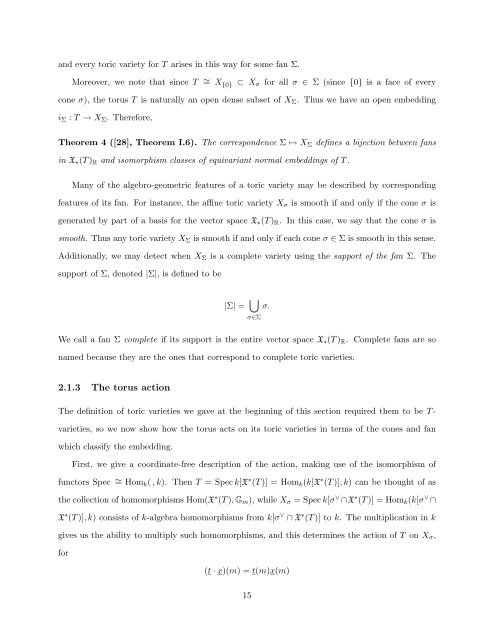Equivariant Embeddings of Algebraic Groups
Equivariant Embeddings of Algebraic Groups
Equivariant Embeddings of Algebraic Groups
Create successful ePaper yourself
Turn your PDF publications into a flip-book with our unique Google optimized e-Paper software.
and every toric variety for T arises in this way for some fan Σ.<br />
Moreover, we note that since T ∼ = X {0}<br />
⊂ X σ for all σ ∈ Σ (since {0} is a face <strong>of</strong> every<br />
cone σ), the torus T is naturally an open dense subset <strong>of</strong> X Σ . Thus we have an open embedding<br />
i Σ : T → X Σ . Therefore,<br />
Theorem 4 ([28], Theorem I.6). The correspondence Σ ↦→ X Σ defines a bijection between fans<br />
in X ∗ (T ) R and isomorphism classes <strong>of</strong> equivariant normal embeddings <strong>of</strong> T .<br />
Many <strong>of</strong> the algebro-geometric features <strong>of</strong> a toric variety may be described by corresponding<br />
features <strong>of</strong> its fan. For instance, the affine toric variety X σ is smooth if and only if the cone σ is<br />
generated by part <strong>of</strong> a basis for the vector space X ∗ (T ) R . In this case, we say that the cone σ is<br />
smooth. Thus any toric variety X Σ is smooth if and only if each cone σ ∈ Σ is smooth in this sense.<br />
Additionally, we may detect when X Σ is a complete variety using the support <strong>of</strong> the fan Σ. The<br />
support <strong>of</strong> Σ, denoted |Σ|, is defined to be<br />
|Σ| = ⋃ σ∈Σ<br />
σ.<br />
We call a fan Σ complete if its support is the entire vector space X ∗ (T ) R . Complete fans are so<br />
named because they are the ones that correspond to complete toric varieties.<br />
2.1.3 The torus action<br />
The definition <strong>of</strong> toric varieties we gave at the beginning <strong>of</strong> this section required them to be T -<br />
varieties, so we now show how the torus acts on its toric varieties in terms <strong>of</strong> the cones and fan<br />
which classify the embedding.<br />
First, we give a coordinate-free description <strong>of</strong> the action, making use <strong>of</strong> the isomorphism <strong>of</strong><br />
functors Spec ∼ = Hom k ( , k). Then T = Spec k[X ∗ (T )] = Hom k (k[X ∗ (T )], k) can be thought <strong>of</strong> as<br />
the collection <strong>of</strong> homomorphisms Hom(X ∗ (T ), G m ), while X σ = Spec k[σ ∨ ∩X ∗ (T )] = Hom k (k[σ ∨ ∩<br />
X ∗ (T )], k) consists <strong>of</strong> k-algebra homomorphisms from k[σ ∨ ∩ X ∗ (T )] to k. The multiplication in k<br />
gives us the ability to multiply such homomorphisms, and this determines the action <strong>of</strong> T on X σ ,<br />
for<br />
(t · x)(m) = t(m)x(m)<br />
15
















